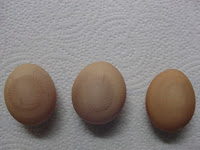
This past week has been really rough on the Clucks! And the humans here too. Saturday morning we woke up to a thick haze and the strong smell of timber burnt smoke. The smoke of wild fires up in Washington was being blown south to us. Basically to the whole Willamette valley. The winds were not of the dangerous intensity, but enough to flip over things that were not battened down. As the day wore on, it got stinkier and smokier.

The Sun looked like a tiny red orb in the sky. It was intense. Sunday, the sky and smell was a little better, and by Monday, we were pretty much back to normal.
Then our new neighbors started on some new construction. Lots of saws buzzing along with the banging of nails and lumber. Plus, another neighbor brought in a tractor for mowing the tall grass that has been left unattended for more than a year (they are trying to sell the property) and so the blades were clanking as the tractor mower moved over the rock-hard ground, while hitting rocks and other debris that had not been cleaned up around all the nursery stock (trees). It was extremely noisy and distracting, considering there's been no real attempt until this week to improve the appearance of the property for several years. The new activity was quite foreign to our ears, after all this time.

Early Monday morning, we heard a dog in our backyardish, barking and barking. When D turned on the yard spot light, it didn't stop, which we thought was hugely odd. Then, all of a sudden it yipped and yodeled... Ahhh, it's a coyote. But it was persistent! It was not going to leave. After about 15 minutes of all this coyote noisy ruckus, it finally quieted down, and we assume it left. We could not actually see it. It was not near any of the coops. So we didn't do any active attempts to find it or scare it away. But when I was leaving the house to go to work, next to the garage door, laid a dead wild bunny with its face mauled off. That was disturbing enough, but even more disturbing was the white gravy looking substance on it's neck and hind quarters. There was even some on the pavement around its little body. I have never seen anything like that on dead victims of coyotes, and believe me, there are lots of coyote victims out here for us to find. This photo is not from our area, but the image accurately represents what we see/experience a lot. So, no, we would never leave our chickens unattended or free to roam across the acreage.
Between all the smoke, noise and predator filled activity this week, our poor chickens have been stressed to the max. Add on the fact that several of our Orloffs are starting into their molt. It has not been a good week! So, we have received only two eggs from them, so far, this week. (Until today!) This morning, when I went out to check, there were hens (four) in all the nesting boxes. This should be a BIG egg delivery day. :)

Additionally, we have been waiting and waiting for the new chickens to start laying eggs. The Welsummers, according to what I have read, can be late bloomers in the egg laying department. I have read that they can start, basically, anywhere from 20 weeks to 40 weeks, with, of course, 30 weeks being the average. But, regardless, I have been checking their box every day right along with all the rest. At 22.5 weeks, it's a WooHoo day for the Welsummers. Two cute, small, chocolate-colored eggs were laid this morning!

Our Orloffs' eggs are a light brown (almost pink) color, weighing anywhere from 45g (1.6 oz) to 67g (2,4 oz) The large eggs are laid by the older hens. The year old hens typically lay medium sized eggs with a few large ones, on occasion. (I'm using the USA egg size standards). Different countries have different standards for
determining egg sizes. Anyway, the new Welsummer pullets are now starting to lay eggs which are distinctly different from our Orloffs! A nice deep brown egg with darker little speckles. The first eggs are 43g/1.5 oz and 41g/1.4 oz. Small and narrow, but it's a start! They will get larger as time progresses.
In the photo with the eggs on the paper, left to right, 1.4g, 1.5g, 1.7g, 1.9g and 2.1g. The first two are considered small and the last two are considered large. There you have it.
I have been apologizing to the chicklets every day for all the stress. Finally, things have settled down and we are getting back to normal. Plus, the added bonus of the new pullets joining the ranks with the other hens.

















































